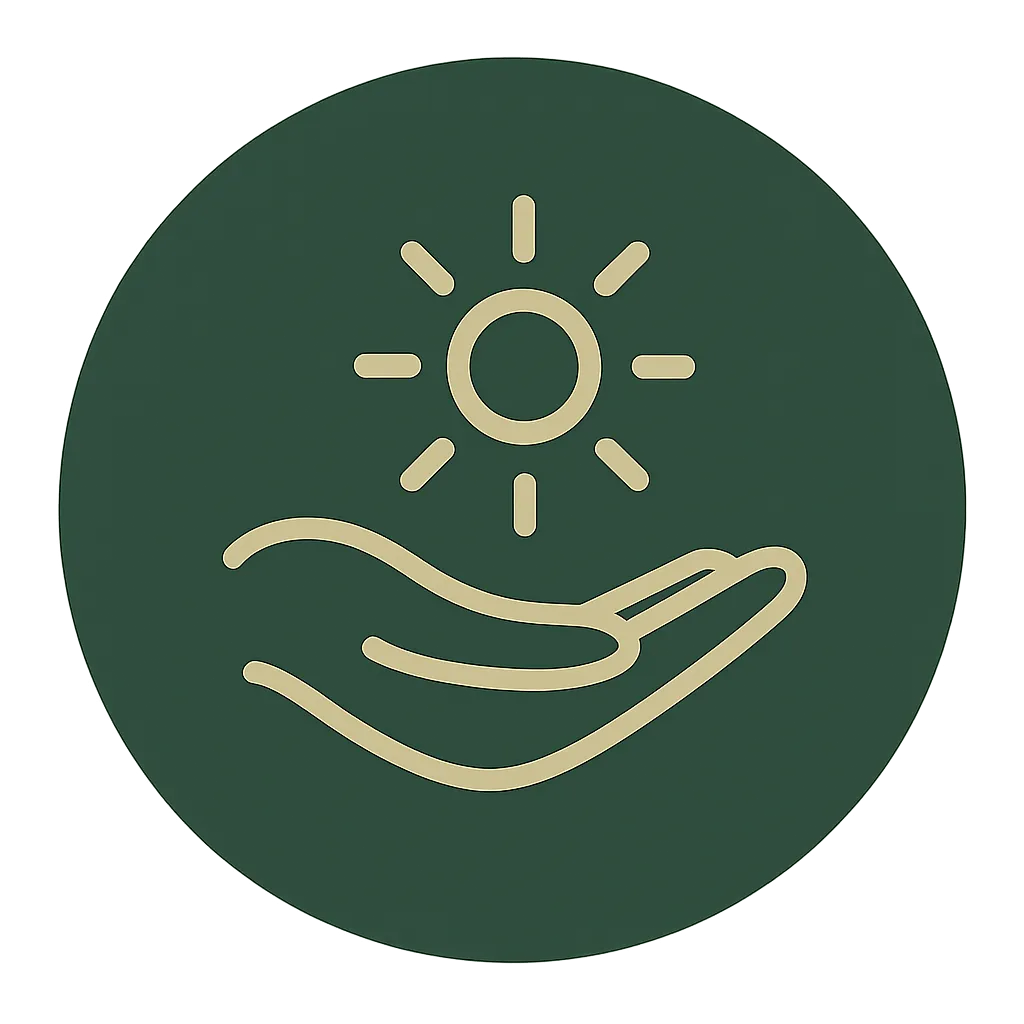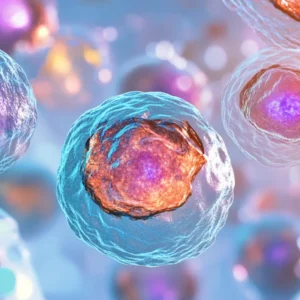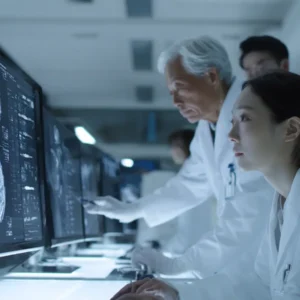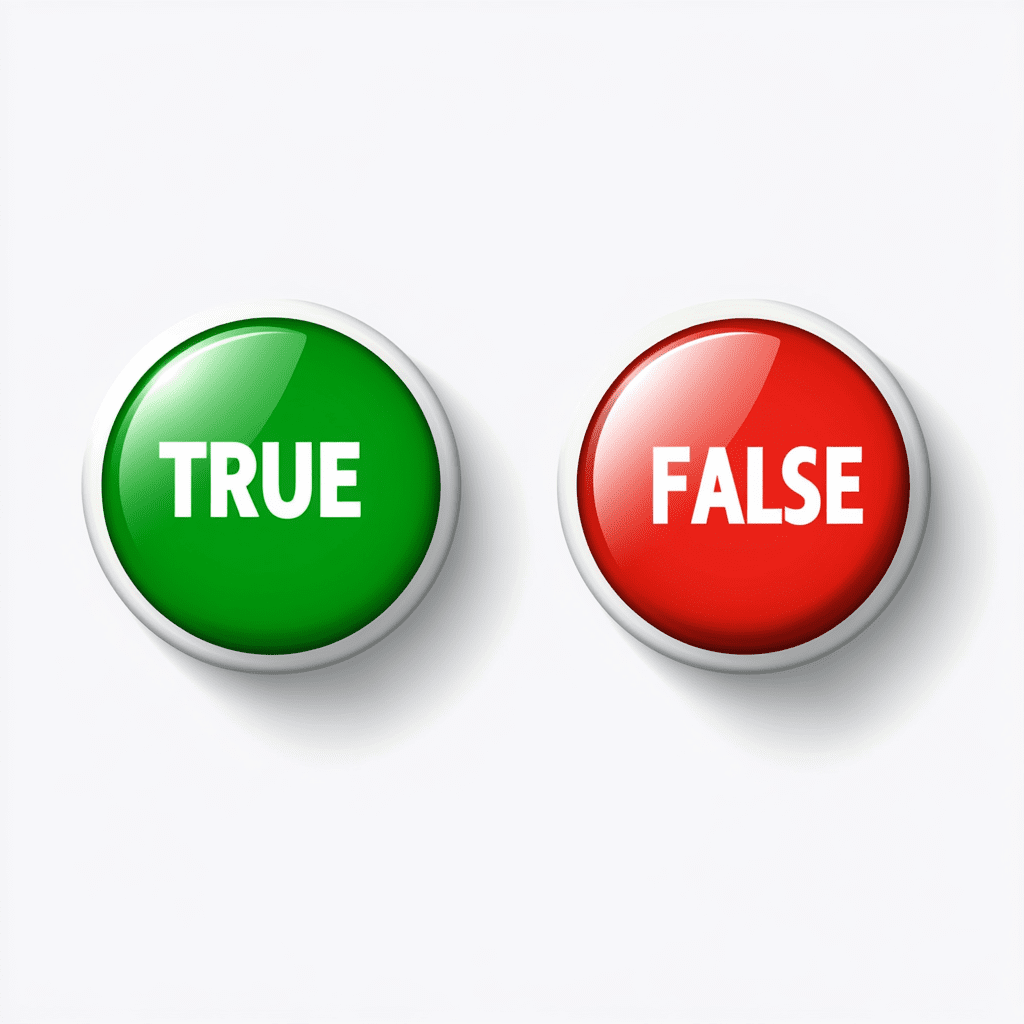Can Stem Cells become the Hair Loss Treatment?
We’ve broken down each study that’s looking into Stem Cells for Hair Loss in detail, but we know it’s a lot to digest.
At the start of the article, we’ve provided an initial summary of what all the research is telling us. If you want to look at any study in particular, use the Content Table on the left to go to a particular study, or the conclusion at the end of the article.
We hope this is helpful!
To look more at Stem Cell treatment processes for Hair Loss & treatment costs, our Stem Cell Therapy for Baldness article might be interesting.
Hair Loss Findings
What the Research Says About Stem Cells for Hair Loss
Looking at the latest data, clinical research consistently shows that stem cell therapy is a safe approach for treating common hair loss (androgenetic alopecia) in both men and women. The most significant benefits seen across multiple studies are a measurable increase in hair density and thickness, with many patients reporting high satisfaction with the results. While not a permanent cure, the treatments have been shown to successfully reactivate dormant hair follicles and improve overall hair fullness.
The primary way these therapies work is not by turning into new hair follicles. Instead, the research overwhelmingly indicates that the stem cells work by releasing a mixture of healing signals, known as the “secretome”. These growth factors and proteins reduce inflammation, improve blood flow to the scalp & “wake up” existing hair follicles. Encouraging them to re-enter the growth phase. Some of the most advanced approaches now use only these cell-free healing signals, sometimes called “conditioned media,” without injecting any live cells at all.
Across numerous trials and reviews, Stem Cell therapies are consistently reported as being very safe, with no serious side effects mentioned. Most issues are minor and temporary, such as mild pain or redness at the injection site.
However, it is crucial to understand the limitations. The research is still in its early stages, with many studies being small and having short follow-up periods. The results are often not permanent, with effects fading after several months. Also the methods used vary widely, making it difficult to determine the single best approach just yet.
Best Stem Cell Therapy clinics for Hair Loss
We don’t let any clinic just sign up or pay to be listed.
We speak to every clinic directly and review their medical team, the treatments they offer, how their stem cells are sourced and how they follow up with patients after treatment.
We also review licensing documents to confirm they meet the legal and medical standards of the country they operate in. For example, whether cells are processed in a GMP-certified facility or if they provide documentation on stem cell quality.
Clinics must also agree to let us collect and publish independent patient reviews. Both positive and negative.

Why Use Alt Treatment?
We don’t just list clinics, we help you choose the right one, get the best pricing and support you through the entire journey. For free.
Compare with Confidence: Get clinic matches based on your condition, location, and budget.
Ask the Right Questions: Know what to ask before committing
Save on Treatment: Unlock exclusive discounts on vetted clinics and follow-up care.
We’re With You After Treatment: We check in post-treatment and help resolve any issues.
Travel & Visa Help: Need to travel for care? We can help with logistics, documents, and local tips.
Found a Clinic Elsewhere? We’ll check their licensing and track record for you, free of charge.
No Strings Attached: Even if you choose a clinic we don’t partner with, we’re still here to help you make the best decision.
Top Stem Cell Therapy Clinics for Hair Loss Treatments
We’ve vetted Stem Cell Therapy clinics Globally who treat Hair Loss. Information on their processes, standards they follow & prices are on their profiles.
Compare Clinics GloballyClinical Studies: What the Science Says
Adipose Derived stem cell conditioned media and minoxidil for hair regrowth in in male Androgenetic Alopecia: Indonesia
You can read more about this study here & here,
Who’s Running It:
The study was conducted by doctors at Dr. Cipto Mangunkusumo Hospital and Universitas Indonesia, supported by the National Research and Innovation Agency (BRIN). It’s the first double-blind randomized trial in Indonesia testing whether a byproduct of stem cells — not the cells themselves — could help regrow hair in men with male-pattern baldness.
Participants:
37 adult men, aged 25 to 59, all diagnosed with androgenetic alopecia (common male-pattern baldness).
To qualify, they had to:
- Have stopped using minoxidil or anti-androgens for at least a month
- Have no other type of hair loss
- Not be on treatments like PRP or finasteride in the last 6 months
What They’re Testing:
The study looked at whether “stem cell conditioned media” (ADSC-CM), a liquid full of healing proteins naturally released by stem cells could help stimulate hair growth when injected into the scalp. Especially when used alongside topical 5% minoxidil, a common hair loss medication.
What is Conditioned Media?
- This isn’t a stem cell transplant. No live stem cells were injected.
- Instead, doctors used the cell-free fluid that stem cells had been grown in like a “stem cell smoothie” full of the growth factors stem cells naturally release.
- These ingredients (like VEGF, IGF-1, and TGF-β) are thought to help repair tissue, improve blood flow, and stimulate hair follicles.
Treatment Setup:
- Each participant’s scalp was split down the middle:
- One side got injections of the stem cell-conditioned media (ADSC-CM)
- The other side got just saline (placebo)
- Participants also applied 1 ml of 5% topical minoxidil to their whole scalp twice daily.
There were two treatment groups:
- Non-concentrated ADSC-CM
- Concentrated ADSC-CM (a stronger dose)
- Injections were given every 2 weeks for 6 weeks (3 sessions total).
How the Conditioned Media Was Made:
- Stem cells were grown from donated human fat tissue.
- The cells were cultured in a lab and then removed. Only the nutrient-rich liquid they left behind was kept.
- This fluid was filtered, frozen, and in one group, concentrated further to boost its effects.
- No live cells were injected, just the signaling molecules they produce.
What They’re Measuring:
Using video trichoscopy, researchers measured:
- Hair count
- Hair density
- Hair thickness
- Terminal vs. vellus (fine) hair ratio
- They also asked patients to rate their satisfaction with results on a 7-point scale.
Results So Far:
- Hair regrowth was seen on both sides of the scalp, even on the placebo side.
“Hair count, density, and thickness improved significantly on both sides after 6 weeks.” – Study findings, page 6
- 81% of participants were “very satisfied” with their results (score of 7 out of 7).
- There were no serious side effects. Some had mild itching, irritation, or temporary redness.
Was There a Difference Between Groups?
No statistically significant difference was found between:
- The stem cell media and placebo sides
- The concentrated and non-concentrated groups
- This suggests the minoxidil + injection process alone may have caused most of the benefit or that the stem cell media effect was too subtle to detect in just 6 weeks.
Possible Reasons Why Both Sides Improved:
- Minoxidil works well on its own
- Injections cause microtrauma, which can stimulate hair growth (like microneedling)
- Growth factors may have spread across the scalp from the treatment side
Final Takeaway:
- This trial shows that stem cell-conditioned media is safe, and it may help regrow hair when paired with minoxidil.
- But in this short trial, it didn’t outperform placebo by a clear margin
If you’re looking at Stem Cell Clinics abroad, the biggest risk your taking is going to a clinic following poor standards. That’s why we take our vetting process so seriously. Read more about our process & why we do what we do below
2. 2020 RepliCel Life Sciences Dermal Sheath Stem Cells Study: RCH-01: Japan
What Is RCH-01?
RCH-01 is a treatment created by a company called RepliCel Life Sciences to help people regrow hair. It uses a person’s own cells, taken from the back of their scalp, to try to wake up thinning or dormant hair follicles and help them grow hair again. Otherwise known as Dermal Sheath Cup Cells.
You can read the full study here.
How Did the Study Work?
- Who took part?
65 people total: 50 men and 15 women between ages 33 and 64, all with pattern hair loss (the kind that slowly thins over time). - What was done?
Doctors took cells from the back of each person’s head, grew more of those cells in a lab, and injected them back into 4 spots on their scalp. - What were the injections?
- Low Dose: 300,000 cells (3.0 × 10⁵)
- A medium dose: 1.5 million cells (1.5 × 10⁶)
- A high dose: 7.5 million cells (7.5 × 10⁶)
- A placebo (no real cells, just a control)
- What did they measure?
- How many new hairs grew (hair count)
- How thick the hairs were
- Measured at 3, 6, 9, and 12 months after treatment
- What Did the Study Find?
- The low dose gave the best results!
- After 6 and 9 months, that area had:
- More hairs than the placebo area
- Thicker hair strands
- More hairs than the placebo area
- It worked well for both men and women
- No serious side effects were reported
- The improvements started to fade by month 12
What Were the Limits?
- They didn’t test if smaller doses might still work
- The effects didn’t last long-term
- They only tested it once per person, so we don’t know if repeat treatments would work better
What Does This Mean?
- This kind of hair treatment looks safe and promising
- It gave moderate hair growth results in both men and women
- The best results were with the lowest dose, which is unusual and needs more research
- Because the effects wore off after about 9 months, people would likely need follow-up treatments for long-term results
Reviews: What Are They?
Hair Loss can be frustrating and overwhelming to treat. We’re not here to hype miracle cures. Our goal is to help you decide for yourself if it’s worth exploring, risks involved & treatment prices around the world.
Get Free GuidanceNo pressure. No spam. Just honest advice to help choose the right clinic.
Studies involve experiments or trials to test something, while reviews analyze and summarize lots of different studies. Reviews give you the bigger picture but don’t bring in new experimental data. Now, let’s look at two important reviews on stem cells for hair loss.
1. 2023 Review on Androgenic Alopecia Trials
What the Review Looked At (here’s the link)
This review looked at 12 high-quality clinical trials from the past decade that tested how well stem cell treatments work for hair loss. Specifically for androgenetic alopecia, the most common type of hair thinning in both men and women. The treatments fell into two main types:
- Cellular, which use actual living stem cells
- Acellular, which use powerful substances made by stem cells like growth factors and proteins to stimulate hair growth
The goal? To find out whether these cutting-edge approaches are safe, and more importantly, if they really help people grow back their hair.
The 5 Categories of Stem Cell Treatments Reviewed
Hair Follicle–Derived Stem Cells (HF-MSCs)
These use cells taken from a person’s own hair follicles usually the back of the head. They are either injected directly or processed into a solution to stimulate nearby hair follicles. Most trials showed an increase in hair density and shaft thickness, though results tended to fade after a few months without retreatment.
Adipose (Fat) Tissue–Derived Stem Cells (ADSCs)
This group included both live fat-derived stem cells and their secretions (called conditioned media). Treatments were given through scalp injections or topical applications, sometimes paired with microneedling or minoxidil. These were among the most effective approaches, showing consistent hair regrowth and thickness improvements in multiple studies.
Bone Marrow–Derived Mononuclear Cells (BMMCs)
These involve extracting stem cells from a person’s bone marrow and injecting them into the scalp. The trial showed promising results for patients who didn’t respond to traditional treatments, but this method was more invasive and came with more side effects like pain and bruising.
Umbilical Cord–Derived Mesenchymal Stem Cells (hUCB-MSCs)
These treatments used paracrine factors,healing molecules secreted by stem cells from donated umbilical cord blood. Applied as a topical serum, they showed strong results in increasing hair thickness and growth, with no serious side effects reported.
Stem Cells from Exfoliated Deciduous (Baby) Teeth (SHED-CM)
This newer approach used cell-free solutions derived from the pulp of naturally shed baby teeth. One trial found it effective in about 75% of participants, with only mild side effects like scalp irritation or small bruises.
Overall Findings
The bottom line? The researchers found that stem cell treatments, whether using live cells or just the healing stuff they produce are generally safe and do help with hair regrowth. People saw thicker, fuller hair in many of the studies.
The catch? The results didn’t always last forever, and some treatments worked better than others. Still, these therapies show real promise, especially when used alongside proven options like hair transplants or medicated creams. The authors also pointed out that we need more long-term studies to figure out the best way to use these treatments and make results more reliable for everyone.
2.Advances in Regenerative Stem Cell Therapy in Androgenic Alopecia and Hair Loss:Italy
You can check out the full review here.
The researchers looked at how stem cells and growth factors help people regrow hair, especially people with androgenic alopecia (AGA). Which is the most common type of hair loss in men and women.
They reviewed several therapies and clinical studies to see:
- Which cell types (like fat stem cells or hair follicle stem cells) are useful?
- What actually happens in the body when these cells are used?
- Which treatments work best based on science and real-world results?
What They Found
1. Hair Regrowth Is Controlled by Special Signals
- Your hair grows in cycles and stem cells control that cycle.
- The Wnt signaling pathway is like a switch that turns hair growth on.
- Other helpful proteins (called growth factors) like VEGF, FGF, IGF-1 help create new blood vessels, boost cell survival, and wake up hair follicles.
2. Three Types of Treatments Seem to Work
A. Platelet Rich Plasma (PRP)
- This is where doctors take your blood, spin it, and inject the platelet-rich part into your scalp.
- Platelets release growth factors that tell your body: “Hey! Grow more hair here!”
- In clinical studies:
- People grew more hair (up to 31% increase in density).
- The hairs also became thicker and healthier.
- Works well for early-stage hair loss.
B. Fat-Derived Stem Cells (AD-SVFs)
- Doctors take a little fat from your body (like with liposuction), extract stem cells, and inject them into the scalp.
- These fat-derived stem cells release helpful signals to wake up sleeping hair follicles.
- In studies:
- People grew more hairs (as much as 31 more hairs per square cm).
- Hair got denser and fuller over 6+ treatments.
- Some patients used the conditioned liquid from the stem cells (not the cells themselves) and still saw growth.
C. Hair Follicle Stem Cells (HFSCs)
- These are stem cells taken from your own scalp, a tiny skin biopsy is spun to isolate cells.
- They’re not grown in labs, just cleaned and injected back in.
- In early studies:
- People had noticeable improvements in hair growth.
- These treatments are promising because they’re minimally manipulated and can be done in a single surgery.
- But the study also found that in people with advanced hair loss, these follicle stem cells are still present yet the cells needed to activate growth (called progenitor cells) are missing or inactive. Which may limit how effective this treatment is in later stages.
3. The Best Therapies Are “Simple but Smart”
- Treatments that don’t manipulate the cells too much (like not growing them in a lab) are:
- Safer
- Faster
- Easier to get approved by the FDA or European agencies
- So doctors can legally use these methods in clinics as long as they follow safe handling procedures.
4. It’s Still Early. But Looks Promising
- These therapies won’t work for everyone, more studies are needed.
- But the combination of fat stem cells and PRP seems the most effective right now.
- Hair follicle stem cell therapies are newer, but could be the future.
- Standardization (using the same method every time) is still a challenge in this field.
Looking into Stem Cell clinics for Hair Loss?
Browse verified stem cell clinics in Colombia, Japan and more that we’ve already personally vetted.
Browse Verified Stem Cell Clinics3. Advances in Regenerative Stem Cell Therapy in Androgenic Alopecia and Hair Loss
Check out the full review here.
What They Looked At
The researchers wanted to understand how stress causes hair loss, especially a condition called alopecia areata and whether stem cell secretions, called the secretome, can help treat it.
They reviewed dozens of studies, including lab tests and animal experiments, that looked at:
- How stress affects the body and leads to hair loss.
- How stem cells, or more specifically, the natural substances they release, might help regrow hair.
What They’re Trying to Find Out
They were looking for answers to these big questions:
- Why does stress cause hair to fall out?
- Can stem cells, or just the helpful fluids they release, reverse that damage and help hair grow back?
- Is it possible to use those fluids (the secretome) as a safer, natural treatment instead of harsh medications?
What They Found
Here’s what they discovered from all the research:
- Stress can trigger the body’s immune system to attack its own hair follicles, especially in people with certain genes.
- This leads to hair loss, sometimes in patches (alopecia areata).
- Current treatments (like creams, pills, and light therapy) don’t work well and often have side effects.
- Stem cells naturally release healing substances, called the secretome, that can calm inflammation, protect hair cells, and restart hair growth.
- In both lab tests and animal studies, these secretions helped:
- Make hair thicker and grow faster.
- Heal the damage caused by stress.
- Restart the hair growth cycle.
What They Concluded
The authors believe that:
- Stem cell secretions (the secretome) could be a natural and powerful new treatment for stress-related hair loss like alopecia areata.
- It’s safer and easier than using full stem cells or medications with side effects.
- It shows a lot of promise but needs more human trials to figure out the right dosage, frequency, and best type of stem cells to use.
In Simple Terms:
Stress can make your body attack your own hair. The natural “juice” from stem cells might stop this, calm the immune system, and help your hair grow back. It’s not yet widely used, but the science so far looks very promising and safer than many current options.
4. 2025 Recent Advances in Drug Development for Hair Loss: Asia
What They Looked At
The researchers reviewed many recent studies and clinical trials about stem cell treatments for hair loss. Instead of running experiments themselves, they collected the latest findings from clinics, biotech companies, and scientific papers around the world, especially from South Korea, Japan, and China, where these treatments are already being tested or used.
They focused on four types of stem cell-based approaches:
- Dermal Papilla Cells (DPCs)
- Dermal Sheath Cup Cells (DSCs)
- Adipose-Derived Stem Cells (ADSCs) (from fat)
- Stromal Vascular Fraction (SVF) (a mixture of cells from fat tissue)
What They’re Trying to Find Out
The goal was to understand:
- Can stem cells actually help regrow hair in people with common hair loss (like male pattern baldness or autoimmune-related bald spots)?
- Which types of stem cells work best?
- Are any of these treatments safe, effective, and ready for use in clinics?
- Can they replace or work better than existing drugs like minoxidil or finasteride?
What They Found
- Dermal Papilla Cells (DPCs) can trigger new hair growth when injected. These are already in clinical trials (e.g., by Epi Biotech).
- Dermal Sheath Cup Cells (DSCs) are being used in Japan by Shiseido, and the treatment is already available there. Early results show strong improvements in both men and women.
- Adipose-Derived Stem Cells (ADSCs) also help regrow hair, either by injecting the cells or just using the nourishing fluid they release. These have shown very promising results in small trials.
- Stromal Vascular Fraction (SVF) is a mix of helpful cells from fat tissue. It improves the scalp environment, reduces inflammation, and leads to thicker, healthier hair after just a few injections.
- These treatments are especially popular in Asia, where regulations make it easier to offer them in clinics. In the U.S. and Europe, they’re mostly still being tested in trials.
5. Human Stem Cell Use in Androgenetic Alopecia: Poland
You can read the full review here
- The authors conducted a systematic review of 15 clinical studies involving 653 patients with Androgenetic Alopecia (AGA) to assess the effectiveness and safety of human stem cell therapies.
- Outcomes assessed: Hair density, hair count, thickness, and safety.
- Sources included: MEDLINE (PubMed), Web of Science, and Scopus.
Types of stem cells studied:
- Hair Follicle-Derived Stem Cells (HFSCs)
- Adipose-Derived Stem Cells (ADSCs)
- Bone Marrow Stem Cells (BMSCs) (in one study)
- Study types: RCTs, non-randomized controlled trials, single-arm studies, and retrospective case series
What They Were Trying to Find Out
The review aimed to determine:
- Whether stem cell-based therapies improve hair growth in men and women with AGA.
- How different stem cell types (HFSCs, ADSCs, BMSCs) compare in efficacy.
- Whether stem cell treatments are safe and free from serious side effects.
- If stem cell therapy could be a viable alternative or complement to conventional AGA treatments like minoxidil or finasteride.
What They Found
Efficacy:
- All included studies reported improvement in hair density after stem cell treatment.
- Most studies showed no major adverse events, only mild or transient side effects.
- Stem cells from hair follicles and adipose tissue were the most commonly used and effective.
- Results from placebo-controlled RCTs consistently favored stem cell therapy.
- Only one study (Tsuboi et al.) reported specific cell counts.
- No study compared all stem cell types head-to-head, and reporting practices were inconsistent.
Safety:
- No major side effects were reported in most studies.
- Minor issues included mild pain, redness, or small hematomas, especially from injections.
- One study (with BMSCs) reported bone pain and fatigue following G-CSF use. The most intensive protocol.
What They Concluded
Stem cell therapy for androgenetic alopecia is a promising, safe, and effective option to improve hair density in both men and women.
However, the authors emphasized:
- A need for standardized protocols (dosing, stem cell type, number of sessions).
- More high-quality randomized controlled trials with larger sample sizes.
- Comparative studies between different stem cell sources (e.g., HFSCs vs ADSCs vs BMSCs).
- Exploration of Wharton’s Jelly stem cells, which have potential but are under-studied
Limitations: What’s the Catch?
Here’s the reality. While stem cell therapy for hair loss shows promise, there are a few things to keep in mind:
- Lack of extensive research. While some smaller studies and trials have shown promising results, the field is still in its early stages, and there is a need for more long-term, large-scale clinical trials to confirm the effectiveness and safety of these treatments.
- Small Groups. Many trials, like the one with 37 participants, are relatively small. Bigger studies are needed to make sure the results apply to more people.
- Short Follow-Up. Most studies only follow people for a few months (like six weeks in the ADSC-CM trial). We don’t know if the benefits last for years or if repeated treatments are needed.
- Lack of Standardization: Studies use different methods, doses, and delivery types, making it hard to compare results or know what actually works best.
- Geographic Differences. The studies were done in specific regions, like Indonesia. People in different parts of the world might respond differently due to genetics and lifestyle.
What They Concluded
The authors believe stem cell therapy is one of the most exciting and effective new options for treating hair loss, especially for people who don’t respond well to existing drugs.
Key takeaways:
- Stem cell treatments can repair and reactivate hair follicles, not just slow hair loss.
- They may offer long-lasting results with fewer side effects.
- As more trials are completed, we’re likely to see stem cell therapy become a standard option in the future.
- However, the treatments are still expensive, and more research is needed to make them affordable and widely available.
Conclusion
The research consistently shows that stem cells help hair growth not by turning into new hair, but by releasing healing signals. Like proteins and growth factors like VEGF, IGF-1, FGF, and Wnt. Confirming that the signals matter more than the cells themselves.
Overall:
- Stem cell therapies are safe, with very few serious side effects reported.
- Many studies show moderate improvements in hair density, thickness, and patient satisfaction especially when stem cells are used alongside proven treatments like minoxidil or PRP.
- Fat-derived stem cells (ADSCs) and hair follicle stem cells (HFSCs) are the most studied, and have shown the most consistent results in clinical trials.
- Benefits can appear after just a few sessions, and short-term regrowth is real. But in many cases, effects begin to fade after several months.
What the Data Doesn’t Tell Us Yet
Despite encouraging results, several key questions remain unanswered:
- Cell Dosage: We don’t yet know how much is enough. Some studies showed better results with lower doses, but dose-response relationships are still unclear.
- Best Stem Cell Type: No studies directly compare ADSCs, HFSCs, BMSCs, or umbilical cord stem cells. Most research has focused on what’s easiest to collect, not necessarily what works best.
- Number of Sessions Needed: Most trials used 1–6 treatments, but we don’t yet know how many are needed for long-term success or how often results fade without retreatment.
- Standard Protocols: Methods vary widely, from injections to topical serums, with or without microneedling or medications. Making it hard to know what the “best practice” actually is.
If you’re deciding which country is best for you, or want to talk about clinics we’ve already vetted, fill out our form below. Our team will guide you with clear, honest answers.
Alt Treatment is a free, independent platform that helps you understand stem cell therapy & decide if it’s right for you.
We break down complex information into clear, honest guidance. When you’re ready, we can connect you with verified clinics that meet your needs, in the right location, and often with exclusive discounts.
There’s no charge to use our platform. No hidden fees. No pressure. Our main aim is to genuinely help you figure out if treatment is right & the best places to consider.
If you want to talk, fill out our form here & our personal concierge team will reach out.
Doctors primarily use stem cell therapy to treat orthopedic issues like osteoarthritis and tendon injuries, repairing tissues and reducing pain. It’s also popular for treating blood disorders and is making waves in cosmetic treatments for skin rejuvenation.
There are also exciting possibilities in other areas, like neurodegenerative and autoimmune diseases, but these uses are less common, and research is still catching up. Stem cell therapy is always evolving, so keep an eye on this space!
If you want to know more, check out our Areas of Treatment Section
Your treatment location, choice of therapy, and negotiation skills directly influence how much you’ll pay!Need a hand? Reach out to us here, and we’ll support you every step of the way!
Stem cell therapy for knees involves using mesenchymal stem cells (MSCs) to help repair damaged cartilage and reduce inflammation in the knee joint. These cells promote tissue healing and can improve mobility and reduce pain. Many clinics offer this as a non-invasive alternative to surgery. Keep in mind, long-term effects and results vary from person to person!
Japan, Colombia, South Korea, & Turkey are amongst the countries you can get Stem Cell Hair Loss treatments in. To view clinics globally that can treat baldness, you can compare them all here.
Fill in your details below
For a discounted offer for Stem Cell Therapy!






